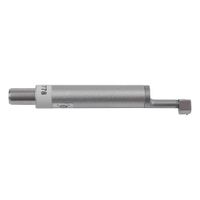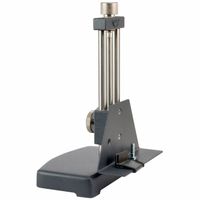Call +(254) 703 030 000 / 751 483 999 / 721 704 777
- Home
- Machining
- Precision Measuring Tools
- Surface Property Testing
- Surface Roughness Tester Accessories
.....Read More
Frequently Asked Questions
What are the essential accessories for a surface roughness tester?
Essential accessories for a surface roughness tester include:
1. **Stylus/Probe**: A critical component that contacts the surface to measure roughness. Different stylus types are available for various surface textures and materials.
2. **Calibration Standards**: Reference materials with known roughness values used to calibrate and verify the accuracy of the tester.
3. **Extension Rods**: Used to extend the reach of the tester for measuring hard-to-access areas or larger components.
4. **V-Blocks and Clamps**: Secure the workpiece in place during measurement to ensure stability and accuracy.
5. **Protective Covers**: Shields the stylus and other sensitive parts from dust and damage when not in use.
6. **Data Cables and Software**: Facilitate data transfer from the tester to a computer for analysis and reporting.
7. **Battery Packs/Chargers**: Ensure the tester is powered for portable use, with spare batteries or chargers for extended operations.
8. **Carrying Case**: Provides safe storage and transport for the tester and its accessories.
9. **Surface Plates**: Provide a stable and flat reference surface for accurate measurements.
10. **Printer**: For on-site printing of measurement results, if not integrated into the tester.
11. **Adapters and Connectors**: Allow compatibility with various devices and measurement setups.
12. **Cleaning Kits**: Maintain the cleanliness and functionality of the stylus and other components.
These accessories enhance the functionality, accuracy, and versatility of a surface roughness tester, ensuring reliable measurements across different applications.
How do extension rods improve surface roughness testing?
Extension rods improve surface roughness testing by providing enhanced accessibility, precision, and versatility. They allow the testing device to reach areas that are otherwise difficult to access, such as deep holes, narrow slots, or recessed surfaces. This capability ensures that measurements can be taken directly on the surface of interest without the need for disassembly or repositioning of the workpiece, which can introduce errors or inconsistencies.
By extending the reach of the testing probe, extension rods help maintain the correct alignment and orientation of the probe relative to the surface being measured. This alignment is crucial for obtaining accurate and repeatable measurements, as any deviation can lead to incorrect readings. The use of extension rods also minimizes the risk of probe deflection or bending, which can occur when trying to measure hard-to-reach areas without proper support.
Furthermore, extension rods can be made from materials that reduce vibration and enhance stability, contributing to more reliable measurements. They can be designed to be lightweight yet rigid, ensuring that the added length does not compromise the performance of the testing device.
In addition, extension rods increase the versatility of surface roughness testers by allowing them to be used in a wider range of applications and environments. This adaptability is particularly beneficial in industries where components have complex geometries or where in-situ testing is required.
Overall, extension rods enhance the capability of surface roughness testing equipment by improving access, maintaining measurement accuracy, and expanding the range of possible applications, leading to more comprehensive and reliable surface quality assessments.
What is the purpose of using tester probes in roughness measurement?
Tester probes in roughness measurement are used to accurately assess the surface texture of a material. Their primary purpose is to provide precise and reliable data on surface irregularities, which is crucial for quality control, product performance, and compliance with industry standards. These probes work by physically contacting the surface and moving across it to detect variations in height, which are then translated into roughness parameters such as Ra (average roughness), Rz (mean roughness depth), and others.
The use of tester probes is essential in various industries, including automotive, aerospace, and manufacturing, where surface finish can significantly impact the functionality, aesthetics, and longevity of a product. For instance, in the automotive industry, the roughness of engine components can affect fuel efficiency and emissions. In electronics, the surface finish of connectors can influence electrical conductivity and signal integrity.
Tester probes are designed to be highly sensitive and capable of measuring minute surface variations, often in the nanometer range. They are typically part of a larger surface roughness tester or profilometer system, which may include digital displays and software for data analysis. The data collected by these probes help in identifying defects, ensuring that surfaces meet specified tolerances, and guiding manufacturing processes to achieve desired surface qualities.
Overall, tester probes are vital tools in ensuring that products meet the required specifications and perform as intended, thereby reducing the risk of failure and enhancing customer satisfaction.
How do stands and brackets enhance the accuracy of surface roughness measurements?
Stands and brackets enhance the accuracy of surface roughness measurements by providing stability, repeatability, and precision. They ensure that the measuring instrument, such as a profilometer or a surface roughness tester, is held in a fixed position relative to the workpiece. This stability minimizes vibrations and external disturbances that could affect the measurement results.
By securely holding the instrument, stands and brackets allow for consistent alignment and positioning, which is crucial for repeatable measurements. This consistency ensures that the measurement path remains the same across multiple tests, reducing variability and improving the reliability of the data.
Moreover, stands and brackets facilitate precise control over the contact between the measuring probe and the surface. This control is essential for maintaining the correct stylus pressure and angle, which are critical factors in obtaining accurate surface roughness readings. Any deviation in these parameters can lead to erroneous measurements.
Additionally, stands and brackets often come with adjustable features that allow for fine-tuning the position and orientation of the measuring device. This adjustability is particularly important when dealing with complex geometries or when measurements need to be taken at specific locations on the workpiece.
In summary, stands and brackets contribute to the accuracy of surface roughness measurements by providing a stable and repeatable setup, ensuring precise control over measurement parameters, and allowing for adjustments to accommodate various measurement scenarios.
Why are specimens important for calibrating surface roughness testers?
Specimens are crucial for calibrating surface roughness testers because they provide a known reference standard against which the device's measurements can be compared and adjusted. Calibration ensures that the tester provides accurate and reliable readings, which is essential for quality control and compliance with industry standards.
Specimens, often referred to as calibration standards or reference samples, have precisely defined surface roughness characteristics. These characteristics are measured and certified by metrology institutes or manufacturers using highly accurate and traceable methods. By using these specimens, technicians can adjust the surface roughness tester to account for any deviations or errors in its readings.
The calibration process involves measuring the specimen with the surface roughness tester and comparing the results to the known values of the specimen. Any discrepancies are used to adjust the tester's settings, ensuring that it provides accurate measurements across its range of operation. This process helps in identifying and correcting systematic errors, such as those caused by wear and tear, environmental factors, or mechanical misalignments.
Regular calibration using specimens is essential for maintaining the tester's accuracy over time. It ensures consistency in measurements, which is critical for processes that rely on precise surface texture, such as machining, coating, and quality assurance in manufacturing. Without proper calibration, measurements could lead to incorrect assessments of product quality, potentially resulting in product failures or non-compliance with specifications.
In summary, specimens are vital for calibrating surface roughness testers because they provide a reliable benchmark for accuracy, ensuring that the testers deliver precise and consistent measurements necessary for maintaining high-quality standards in various industrial applications.
What types of tester cables are compatible with surface roughness testers?
Surface roughness testers typically use specific types of cables to connect the probe or sensor to the main unit for data transmission and power supply. The compatibility of tester cables with surface roughness testers depends on the model and manufacturer, but generally, the following types are commonly used:
1. **RS-232 Cables**: These are standard serial communication cables used for connecting the surface roughness tester to computers or other devices for data transfer. They are compatible with many older models and some current models that support serial communication.
2. **USB Cables**: Many modern surface roughness testers use USB cables for connectivity. These cables allow for easy connection to computers for data transfer and device configuration. USB Type-A to USB Type-B or USB Type-C are common variations.
3. **Proprietary Cables**: Some manufacturers design proprietary cables specifically for their surface roughness testers. These cables are tailored to fit the unique ports and connectors of the device, ensuring optimal performance and compatibility.
4. **RJ-45 Cables**: In some cases, surface roughness testers may use RJ-45 cables, similar to Ethernet cables, for network connectivity or data transfer.
5. **Bluetooth or Wireless Adapters**: While not cables per se, some modern surface roughness testers offer wireless connectivity options, including Bluetooth, which may require specific adapters or dongles for compatibility.
6. **Analog Cables**: For older models, analog cables might be used to connect the probe to the main unit, transmitting signals in an analog format.
When selecting cables, it is crucial to refer to the manufacturer's specifications and guidelines to ensure compatibility and optimal performance.
How can I replace or maintain worn-out probes for my surface roughness tester?
1. **Identify the Probe Type**: Determine the specific type and model of the probe used in your surface roughness tester. Refer to the user manual or manufacturer's documentation for details.
2. **Procure Replacement Probes**: Contact the manufacturer or authorized distributor to purchase the correct replacement probes. Ensure compatibility with your tester model.
3. **Prepare the Equipment**: Turn off the surface roughness tester and disconnect it from any power source to ensure safety during the replacement process.
4. **Remove the Worn-Out Probe**: Carefully detach the worn-out probe from the tester. This may involve unscrewing or unclipping it, depending on the design. Handle with care to avoid damaging the tester.
5. **Install the New Probe**: Attach the new probe by aligning it correctly with the connection point on the tester. Secure it firmly in place, ensuring it is properly seated and connected.
6. **Calibration**: After installation, calibrate the tester with the new probe. Follow the manufacturer's instructions for calibration to ensure accurate measurements.
7. **Test Functionality**: Perform a test measurement on a known reference surface to verify that the new probe is functioning correctly and providing accurate readings.
8. **Regular Maintenance**: To maintain the probes, clean them regularly with a soft, lint-free cloth. Avoid using harsh chemicals that could damage the probe.
9. **Storage**: When not in use, store the probes in a protective case to prevent physical damage and contamination.
10. **Documentation**: Keep records of probe replacements and maintenance activities for future reference and warranty purposes.
11. **Training**: Ensure that personnel handling the probes are trained in proper handling and maintenance procedures to extend the life of the probes and ensure accurate measurements.



